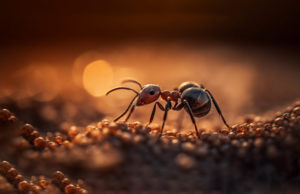One of the commonest household pests is ants. These insects can easily infest homes, since they are tiny and have the ability to go through the smallest of cracks. Although the presence of ants may not be dangerous initially, it is very important to determine the species of ants infesting this habitat. Some species may lead to structural damage, food contamination, or even some painful bites.
This guide will discuss the different types of ants that could be in your home. By identifying the type you are facing, it will be easy to control and get rid of them by choosing a right pest control company.
10 Different Types Of Ants That Coulb Be Found In Your Home
1. Carpenter Ants
Carpenter ants are bigger compared to the various other types of ants, they would usually measure 6-12mm in size. In color, they are black, reddish-black, or brown and look smooth. They may be found in places such as basements or attics or near leaking pipes since these ants tend to thrive on moist or rotten wood.
These ants do not feed on wood like termites, but work on hollowing out their nests in the wood. This may make wooden buildings lose strength after some time. See heaps of sawdust on the floor or even nebulous rustling sounds behind walls, and that could be a carpenter ant nest.
2. Odorous House Ants
Odorous house ants are small in size with a length of about 2.53 -3mm. When crushed they often have a distinctive empty coconut smell and are brown or black. These ants love sugar and greasy foodstuff so you will be tempted to encounter them in your kitchen very often.
These ants usually get their way into the homes through crevices in the walls, windows or even utility lines. Their nests are difficult to find because they get attracted by numerous locations such as under sinks, in cabinets, or under the tiles on the floor.
3. Argentine Ants
Medium-sized ants (2.2-2.8 mm long) and light brown to dark brown, called Argentine ants. They do not like any other ants as they associate in huge colonies having multiple queens. These colonies tend to crowd out other species of ants in the locality and hence they are highly invasive.
You will most likely see Argentine ants around places where there is water, like dripping faucets or water around pets, or even kitchens. They are tireless foragers, and they tend to create evident paths towards food outlets.
4. Fire Ants
Fire ants are stinging and uncompassionate. They are reddish-brown in color with 1.6-5 mm in dimensions. The fire ants are quite recognizable due to the large piles that they form outside but sometimes one can be able to find them in the house when there is some form of food available.
When ants are stung, they release venom in the process which burns and leaves an itchy welts on the skin. This makes them particularly deadly to children or those allergic to the sting of insects where severe reactions can take place.
5. Pharaoh Ants
They are small ants and have a yellow or light brown color, less than 2 mm in length. So, they are infamous for being hard to handle since their colonies may include thousands of ants. They divide their colonies into separate smaller units when they are threatened and go on their own.
These ants tend to be attracted to warm moist compartments and they are usually common in the bathroom, kitchen, and around heating systems. The presence of Pharaoh ants poses a health hazard to those places that prepare food because they have the potential to harbor harmful bacteria.
6. Pavement Ants
Pavement ants are dark brown and black and 2.5 4 mm in length. The name they got reflects their tendency to nest in cracks in pavement, under rocks, and between floorboards in basements or garages.
The pavement ants do not form as aggressive colonies as the fire ants do, however, most of the time they form conspicuous pathways as they seek food. They prefer sugary materials, grains and even crumbs on kitchen tops.
7. Ghost Ants
The ghost ants are very minute (1.31.5 mm) with transparent legs and abdomen. They are called so because of their pale skin, which makes them difficult to notice. The habitat of these ants is normally warm and humid.
Ghost ants are attracted to sweets, and they can be seen around spills containing a lot of sugar or open food packets. They build their nests outside, yet they will make their way into homes in search of food.
8. Acrobat Ants
The acrobat ants are easily identified by their heart shaped abdomens which they tend to raise when threatened. They are 2.53 mm to 3 mm long, are usually black or brown, or reddish. These ants like to nest in wet woods or decomposing spots.
They are not as devastating as carpenter ants, though they have the capacity of destroying properties without being controlled. Trees, shrubs, and wet areas inside walls tend to take the fancy of the Acrobat ants.
9. Crazy Ants
The crazy ants are named the way they move erratically. Their size is approximately 2.23mm-3mm and they may be black, reddish-brown. These ants live comfortably in diverse conditions. They are found in such places as under baseboards, in wall voids or outdoor soil.
Their unusual aspect is the absence of a central nesting location. This may make them more difficult to trace and kill. And they are very invasive and fast to infiltrate all buildings.
10. Little Black Ants
Little black ants are a very common types of ants in the household. They are very minute, about 1.5- 2 mm long, and jet black in color. As they normally have their footprints easily observable given the fact that they move in large congregations.
They build their nests on wall cavities, behind baseboards or underneath wood piles. Though being non-dangerous, their continuous presence may be irritating, at least, in the kitchen.







